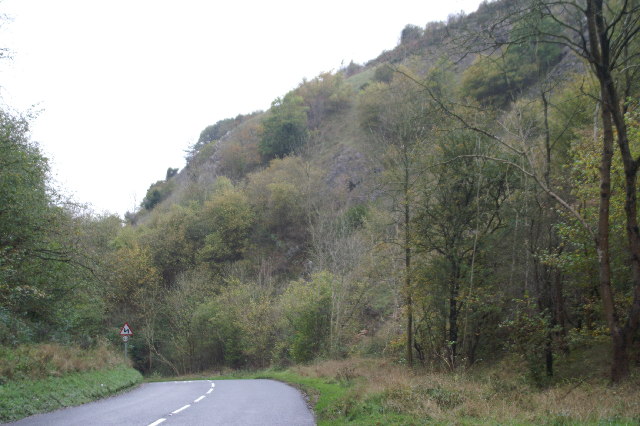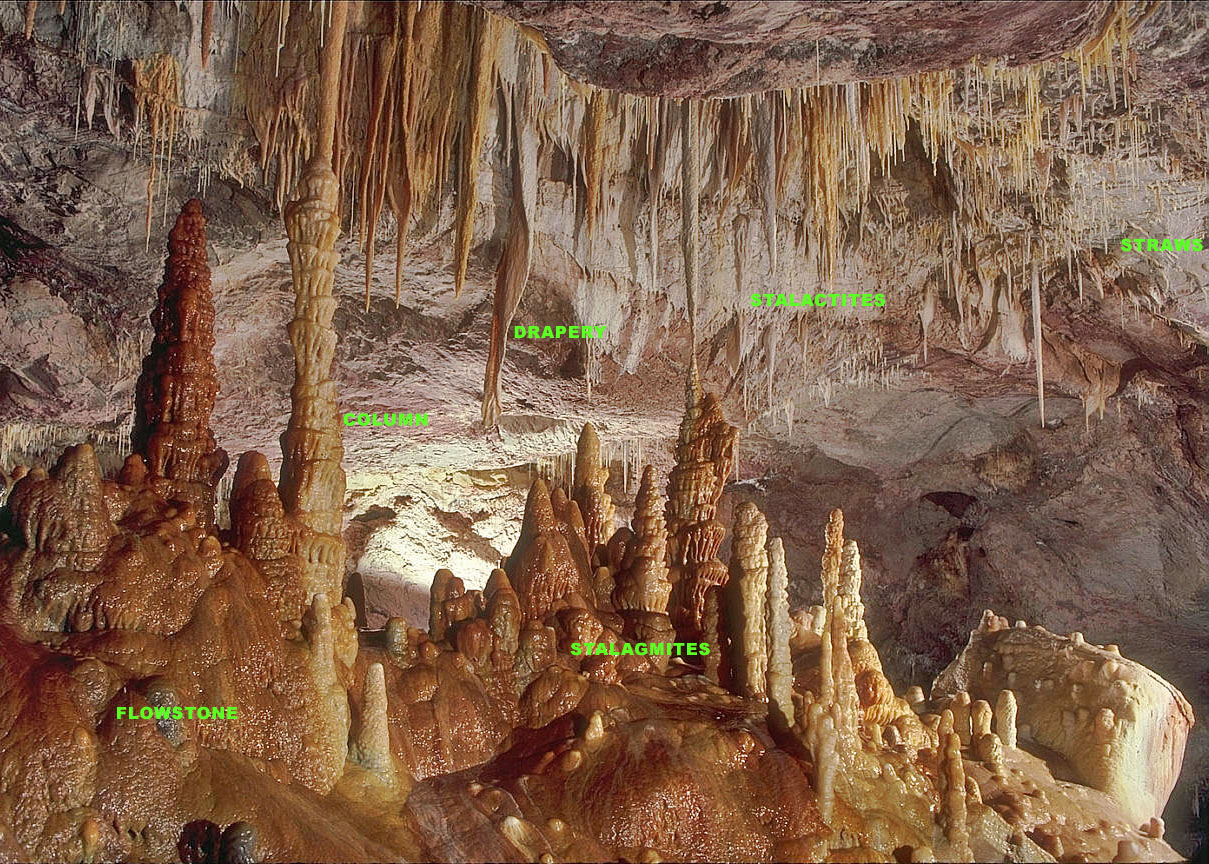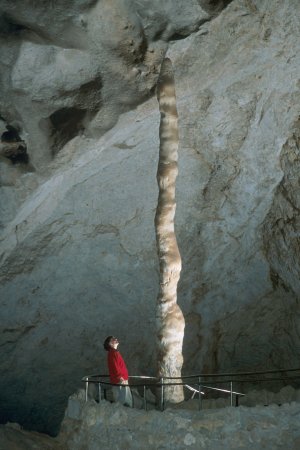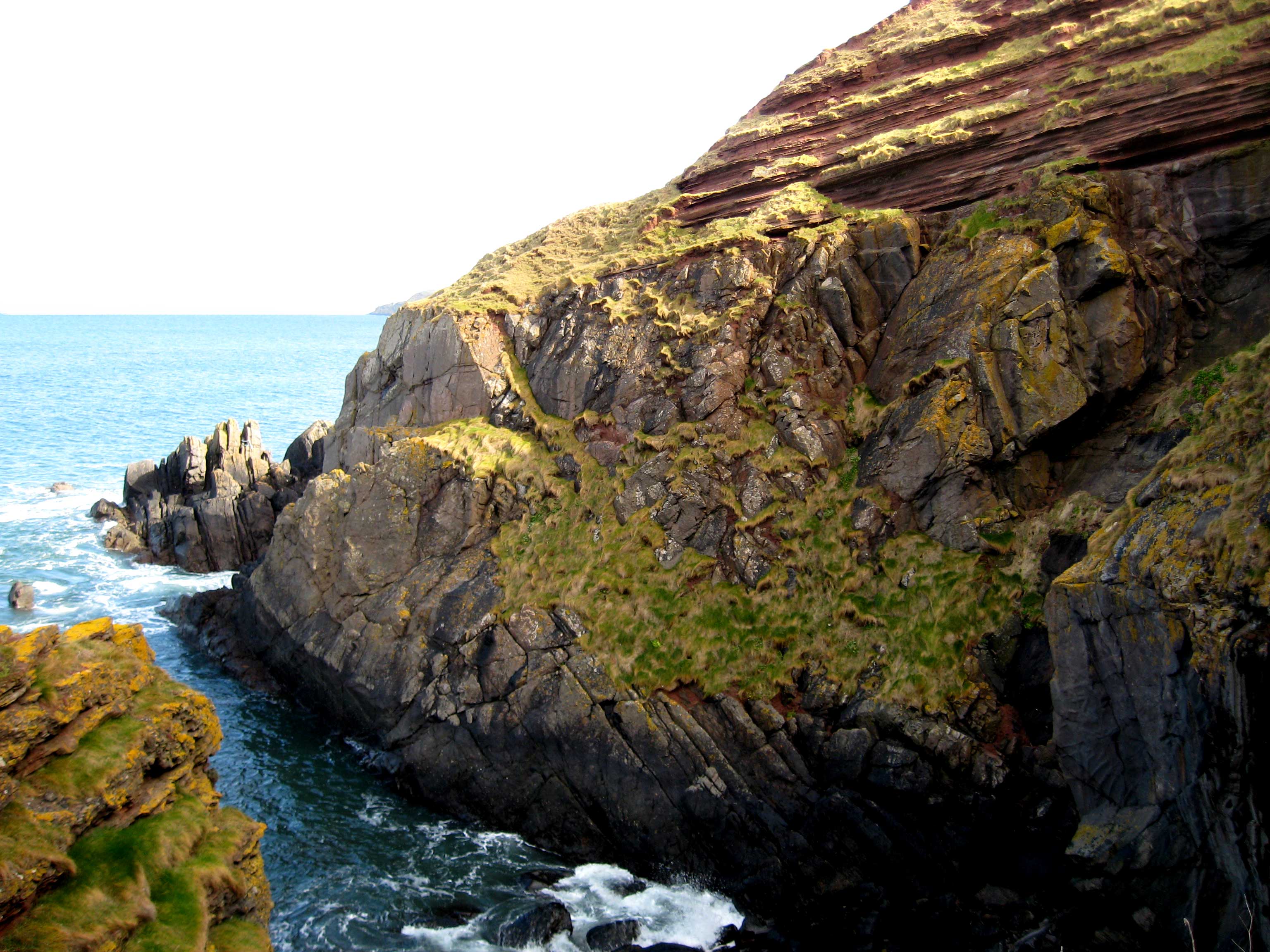|
Rod's Pot
Rod's Pot is a limestone cave above Burrington Combe in the Mendip Hills, in Somerset, England. The cave was first excavated in 1944 by the University of Bristol Spelæological Society. It is one of a line of swallets marking the junction of the Limestone shales with the Carboniferous Limestones where water running off the Old Red Sandstone of Blackdown finds its way underground. Further excavation has now linked Rod's Pot to nearby Bath Swallet. The cave was originally known as Pearce's Pot after Rodney Pearce. Main features Rod's Pot is formed mainly of vertical rift passages, probably in the original joints in the limestone which have been enlarged by water action. The north wall of the main chamber is a continuation of the main chamber in Read's Cave, a quarter mile to the west. The entry chamber divides into two passages about high and long. They merge again at the top of a deep vertical pothole which is a dead end. From the top of the pothole a long passage ... [...More Info...] [...Related Items...] OR: [Wikipedia] [Google] [Baidu] |
Burrington Combe
Burrington Combe is a Carboniferous Limestone gorge near the village of Burrington, on the north side of the Mendip Hills Area of Outstanding Natural Beauty, in North Somerset, England. "Combe" or "coombe" is a word of Celtic origin found in several forms on all of the British Isles, denoting a steep-sided valley or hollow. Burrington Combe is a gorge through the limestone hills although there is now no river running through it. Various cave entrances are exposed which have been occupied by humans for over 10,000 years, with a hillfort being built beside the combe in the Iron Age. The geology has led to a diversity of plant life. According to legend Augustus Montague Toplady was inspired to write the hymn ''Rock of Ages'' while sheltering under a rock in the combe, although recent scholars have disputed this claim. Geology Water draining from Black Down has exposed rocks from the Devonian sandstones of the Portishead Formation which show through the limestone, Carbon ... [...More Info...] [...Related Items...] OR: [Wikipedia] [Google] [Baidu] |
Carboniferous Limestone
Carboniferous Limestone is a collective term for the succession of limestones occurring widely throughout Great Britain and Ireland that were deposited during the Dinantian Epoch of the Carboniferous Period. These rocks formed between 363 and 325 million years ago. Within England and Wales, the entire limestone succession, which includes subordinate mudstones and some thin sandstones, is known as the Carboniferous Limestone Supergroup. Depositional basins Within Great Britain the suite of rocks known traditionally as the Carboniferous Limestone Series was deposited as marine sediments in three distinct ‘provinces’ separated by contemporary landmasses. One of these landmasses was the Wales-London-Brabant Massif, an east–west aligned belt of land stretching through central Wales and the English Midlands to East Anglia and on into Belgium. The limestones deposited to its south form a distinct South Wales-Mendip province which extends from Pembrokeshire in the west ... [...More Info...] [...Related Items...] OR: [Wikipedia] [Google] [Baidu] |
Caves Of The Mendip Hills
The caves of the Mendip Hills are formed by the particular geology of the Mendip Hills: large areas of limestone worn away by water makes it a national centre for caving. The hills conceal the largest underground river system in Britain. Geology The hills consist of anticlines of Carboniferous Limestone lying over Devonian Old Red Sandstone, with the sandstone exposed on the summits. When a surface stream running off the sandstone reaches the limestone it sinks below ground through a " swallet", (also known locally as a "slocker"), continuing on its way down towards sea level by enlarging existing cracks in the rock to form caves, and reappearing at the base of the limestone outcrop. As the water changes route within the hill some caves (or parts of caves) are left dry. There is a characteristic type of Mendip cave, in which there is an initially steep descent, and then a more level stretch ending in a "sump" as the cave reaches and descends below the prevailing water table. T ... [...More Info...] [...Related Items...] OR: [Wikipedia] [Google] [Baidu] |
Niphargus Fontanus
''Niphargus'' is by far the largest genus of its family, the Niphargidae, and the largest of all freshwater amphipod genera. Usually, these animals inhabit caves or groundwater. They occur in western Eurasia, in regions that were not covered by the Pleistocene ice sheets. They are found throughout most of Europe with the notable exception of the Nordics and they are also largely missing from Iberia. The genus extends into Asia as far as the Arabian Peninsula and Iran. In their main range – the central Mediterranean region through Central and Eastern Europe to the Ukraine – they are among the most significant organisms inhabiting the groundwater. In the Dinaric Alps alone there are at least 45 species. There are also six species in the British Isles (the northernmost ''Niphargus''): ''N. aquilex'', ''N. fontanus'', ''N. glenniei'' and ''N. kochianus'' of Great Britain, and ''N. irlandicus'' and ''N. wexfordensis'' of Ireland. Although the individual species often hav ... [...More Info...] [...Related Items...] OR: [Wikipedia] [Google] [Baidu] |
Translucent
In the field of optics, transparency (also called pellucidity or diaphaneity) is the physical property of allowing light to pass through the material without appreciable scattering of light. On a macroscopic scale (one in which the dimensions are much larger than the wavelengths of the photons in question), the photons can be said to follow Snell's law. Translucency (also called translucence or translucidity) allows light to pass through, but does not necessarily (again, on the macroscopic scale) follow Snell's law; the photons can be scattered at either of the two interfaces, or internally, where there is a change in index of refraction. In other words, a translucent material is made up of components with different indices of refraction. A transparent material is made up of components with a uniform index of refraction. Transparent materials appear clear, with the overall appearance of one color, or any combination leading up to a brilliant spectrum of every color. The opposit ... [...More Info...] [...Related Items...] OR: [Wikipedia] [Google] [Baidu] |
Stalactite
A stalactite (, ; from the Greek 'stalaktos' ('dripping') via ''stalassein'' ('to drip') is a mineral formation that hangs from the ceiling of caves, hot springs, or man-made structures such as bridges and mines. Any material that is soluble and that can be deposited as a colloid, or is in suspension, or is capable of being melted, may form a stalactite. Stalactites may be composed of lava, minerals, mud, peat, pitch, sand, sinter, and amberat (crystallized urine of pack rats). A stalactite is not necessarily a speleothem, though speleothems are the most common form of stalactite because of the abundance of limestone caves. The corresponding formation on the floor of the cave is known as a stalagmite. Mnemonics have been developed for which word refers to which type of formation; one is that ''stalactite'' has a C for "ceiling", and ''stalagmite'' has a G for "ground". Another example is that ''stalactites'' "hang on ''T''ight" and ''stalagmites'' "''M''ight grow up" � ... [...More Info...] [...Related Items...] OR: [Wikipedia] [Google] [Baidu] |
Stalagmite
A stalagmite (, ; from the Greek , from , "dropping, trickling") is a type of rock formation that rises from the floor of a cave due to the accumulation of material deposited on the floor from ceiling drippings. Stalagmites are typically composed of calcium carbonate, but may consist of lava, mud, peat, pitch, sand, sinter, and amberat (crystallized urine of pack rats). The corresponding formation hanging down from the ceiling of a cave is a stalactite. Mnemonics have been developed for which word refers to which type of formation; one is that ''stalactite'' has a C for "ceiling", and ''stalagmite'' has a G for "ground", another is that, as with ants in the pants, the mites go up and the tights (tites) come down. Formation and type Limestone stalagmites The most common stalagmites are speleothems, which usually form in limestone caves. Stalagmite formation occurs only under certain pH conditions within the cavern. They form through deposition of calcium carb ... [...More Info...] [...Related Items...] OR: [Wikipedia] [Google] [Baidu] |
Old Red Sandstone
The Old Red Sandstone is an assemblage of rocks in the North Atlantic region largely of Devonian age. It extends in the east across Great Britain, Ireland and Norway, and in the west along the northeastern seaboard of North America. It also extends northwards into Greenland and Svalbard. These areas were a part of the ancient continent of Euramerica/Laurussia. In Britain it is a lithostratigraphic unit (a sequence of rock strata) to which stratigraphers accord supergroup status and which is of considerable importance to early paleontology. For convenience the short version of the term, ORS is often used in literature on the subject. The term was coined to distinguish the sequence from the younger New Red Sandstone which also occurs widely throughout Britain. Sedimentology The Old Red Sandstone describes a suite of sedimentary rocks deposited in a variety of environments during the Devonian but extending back into the late Silurian and on into the earliest part of the ... [...More Info...] [...Related Items...] OR: [Wikipedia] [Google] [Baidu] |
Sinkhole
A sinkhole is a depression or hole in the ground caused by some form of collapse of the surface layer. The term is sometimes used to refer to doline, enclosed depressions that are locally also known as ''vrtače'' and shakeholes, and to openings where surface water enters into underground passages known as '' ponor'', swallow hole or swallet. A '' cenote'' is a type of sinkhole that exposes groundwater underneath. A ''sink'' or ''stream sink'' are more general terms for sites that drain surface water, possibly by infiltration into sediment or crumbled rock. Most sinkholes are caused by karst processes – the chemical dissolution of carbonate rocks, collapse or suffosion processes. Sinkholes are usually circular and vary in size from tens to hundreds of meters both in diameter and depth, and vary in form from soil-lined bowls to bedrock-edged chasms. Sinkholes may form gradually or suddenly, and are found worldwide. Formation Natural processes Sinkholes may capture ... [...More Info...] [...Related Items...] OR: [Wikipedia] [Google] [Baidu] |
Somerset
( en, All The People of Somerset) , locator_map = , coordinates = , region = South West England , established_date = Ancient , established_by = , preceded_by = , origin = , lord_lieutenant_office =Lord Lieutenant of Somerset , lord_lieutenant_name = Mohammed Saddiq , high_sheriff_office =High Sheriff of Somerset , high_sheriff_name = Mrs Mary-Clare Rodwell (2020–21) , area_total_km2 = 4171 , area_total_rank = 7th , ethnicity = 98.5% White , county_council = , unitary_council = , government = , joint_committees = , admin_hq = Taunton , area_council_km2 = 3451 , area_council_rank = 10th , iso_code = GB-SOM , ons_code = 40 , gss_code = , nuts_code = UKK23 , districts_map = , districts_list = County council area: , MPs = * Rebecca Pow (C) * Wera Hobhouse ( LD) * Liam Fox (C) * David Warburton (C) * Marcus Fysh (C) * Ian Liddell-Grainger (C) * James Heappey (C) * Jacob Rees-Mogg (C) * John Penrose (C) , police = Avon and Somerset Polic ... [...More Info...] [...Related Items...] OR: [Wikipedia] [Google] [Baidu] |
University Of Bristol Spelæological Society
The University of Bristol Spelæological Society (UBSS) was founded in 1919 by cavers in the University of Bristol. Among its earliest activities was the archaeological excavation of Aveline's Hole. The club owns a hut, which was formerly a ladies' cricket pavilion. It was bought in 1919 for £5 and moved from its original plot to Burrington Combe, where it still stands. Publications and library The club maintains one of the largest collections of caving books and journals in the country in its library in Bristol, as well as publishing the long-standing academic journal, ''Proceedings of the University of Bristol Spelæological Society''. Following numerous expeditions to the Burren, County Clare over the years, the UBSS has published the definitive guides to the caves of the region: ''Caves of Northwest Clare'' (1969), ''Caves of County Clare'' (1981), ''Caves of County Clare & South Galway'' (2003), ''Caves of Mid-West Ireland'' (2019) and ''Caves of southern Ireland'' (2022). ... [...More Info...] [...Related Items...] OR: [Wikipedia] [Google] [Baidu] |
England
England is a country that is part of the United Kingdom. It shares land borders with Wales to its west and Scotland to its north. The Irish Sea lies northwest and the Celtic Sea to the southwest. It is separated from continental Europe by the North Sea to the east and the English Channel to the south. The country covers five-eighths of the island of Great Britain, which lies in the North Atlantic, and includes over 100 smaller islands, such as the Isles of Scilly and the Isle of Wight. The area now called England was first inhabited by modern humans during the Upper Paleolithic period, but takes its name from the Angles, a Germanic tribe deriving its name from the Anglia peninsula, who settled during the 5th and 6th centuries. England became a unified state in the 10th century and has had a significant cultural and legal impact on the wider world since the Age of Discovery, which began during the 15th century. The English language, the Anglican Church, and Eng ... [...More Info...] [...Related Items...] OR: [Wikipedia] [Google] [Baidu] |







.jpg)
